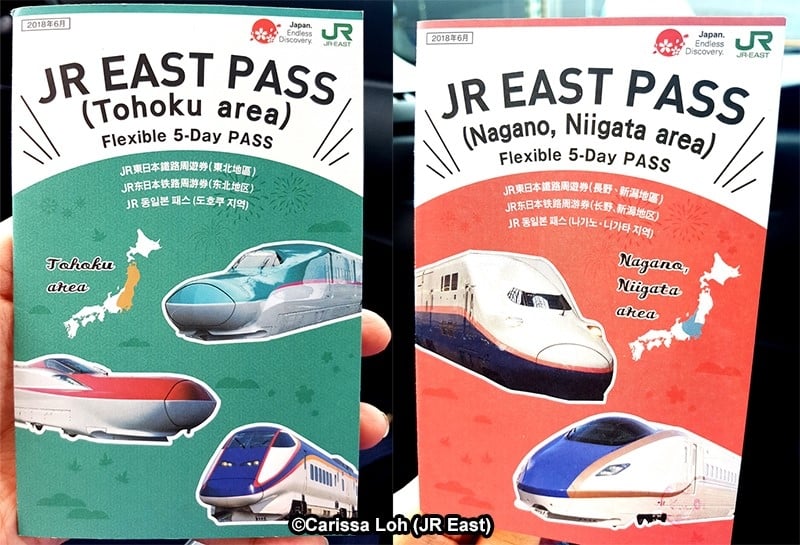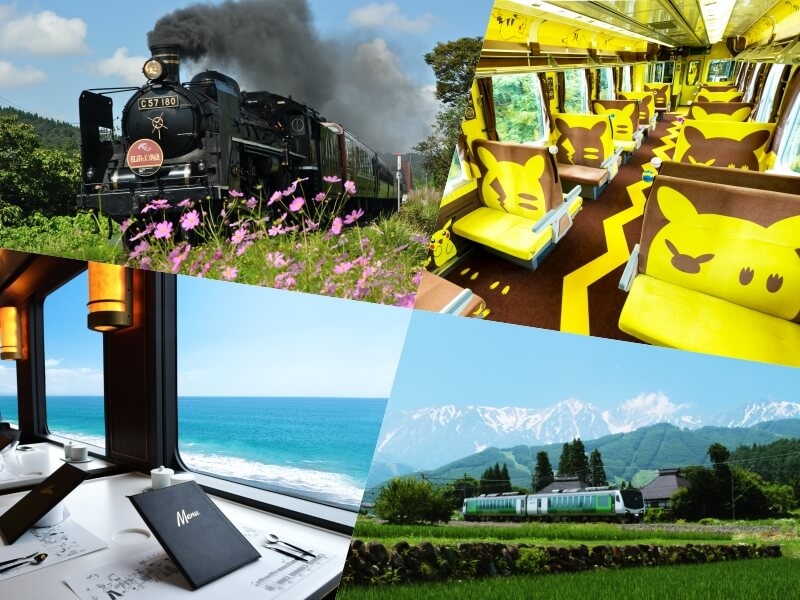
Image credit: East Japan Railway Company
Japan may be synonymous with shinkansen (bullet trains)—high-speed and high-tech—but local lines traversing the countryside also offer unforgettable travel experiences. In the Eastern Japan area, JR East’s Joyful Trains were created for that purpose, to bring you on a fun-filled train ride while discovering local gems along the route!
Not just a means of transportation, each Joyful Trains has its own unique features, and can be split into four categories based on these features:
- Trains with unique interiors and on-board activities
- Scenic trains with fun station activities
- Steam locomotive (SL) trains
- Restaurants trains (with scenic views)
Which ones would you be interested to take a trip on? Most of them are free to ride with a JR EAST PASS, so why not hop on for a fun ride the next time you are in Japan? Read on to find out more about each train!
| The JR EAST PASS (Tohoku area) and JR EAST PASS (Nagano, Niigata area) offer incredible value for unlimited rides all over Eastern Japan. What’s more, all JR East shinkansen, express and regular trains, and even Joyful Trains within the valid area are available to travel on!
Explore each destination to its fullest before you head off to your next, as the Pass allows for any 5 days of usage within a 14-day period. |
Trains with unique interiors and on-board activities
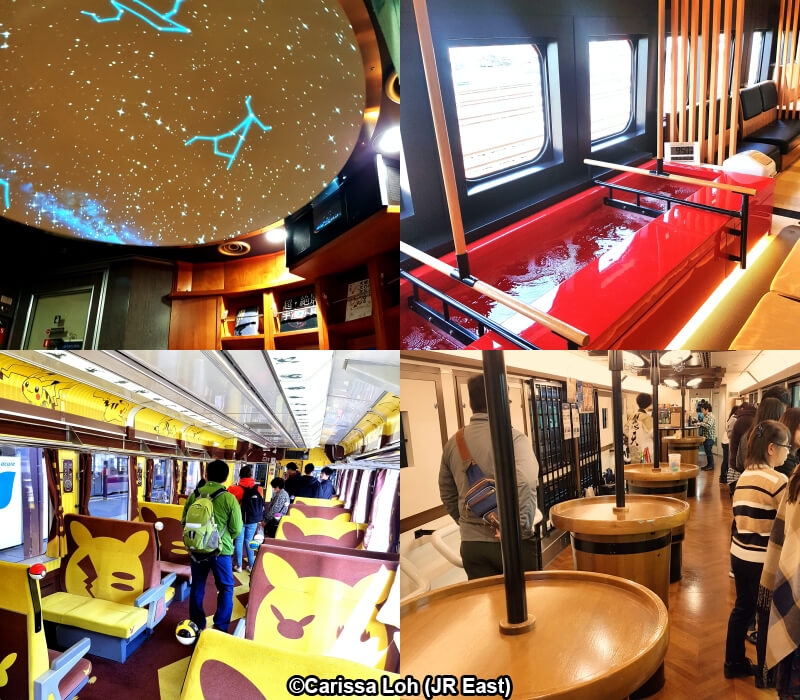
Image credit: Carissa Loh (East Japan Railway Company)
While you might not be able to tell just from looking at the train’s exterior, the interiors of these trains have been painstakingly decorated with one-of-a-kind installations, built around a distinctive theme.
With special features ranging from relaxing footbaths to domed planetariums, or meticulously decorated interiors, on-board musical performances, and events like sake-tasting, you might even have a hard time believing that you are on a train!
Toreiyu Tsubasa: the footbath bullet train
Route: Fukushima Station (福島駅) ↔ Shinjо̄ Station (新庄駅) on the Yamagata Shinkansen Line
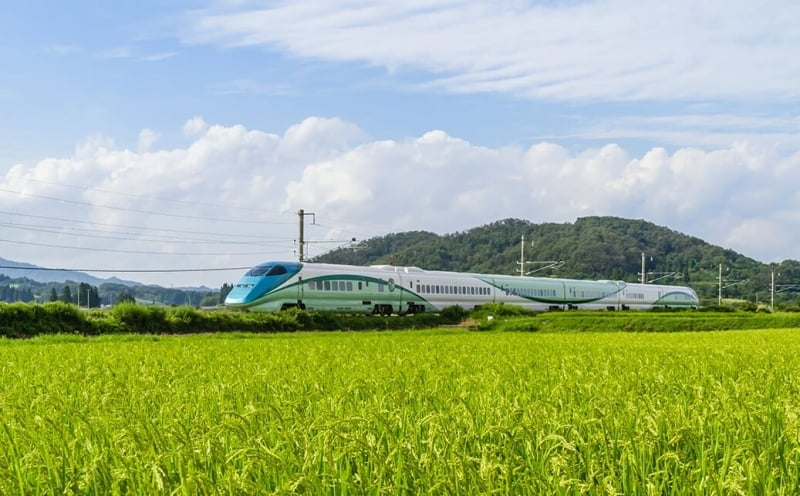
Image credit: East Japan Railway Company
Yamagata is well-known for its healing hot springs and fresh fruit, and the Toreiyu Tsubasa is a bullet train built to pay tribute to these, by incorporating tatami seats, fruit motifs and footbaths on-board the train.
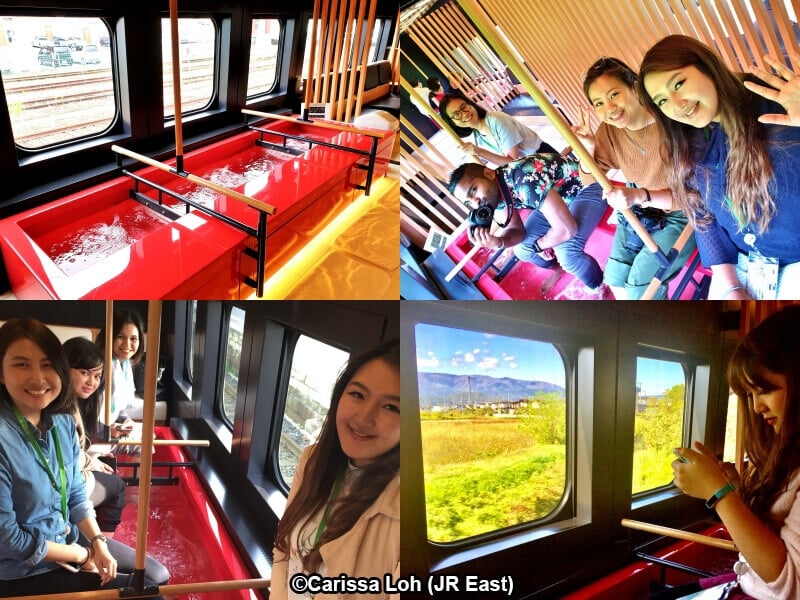
Image credit: Carissa Loh (East Japan Railway Company)
One thing you absolutely must try while on the Toreiyu Tsubasa is the footbaths. A fun and relaxing activity, you will even get a mini towel and bag as a souvenir, just like the ones you use at hot springs! The footbaths face the windows, from which you can gaze at the passing countryside scenery.
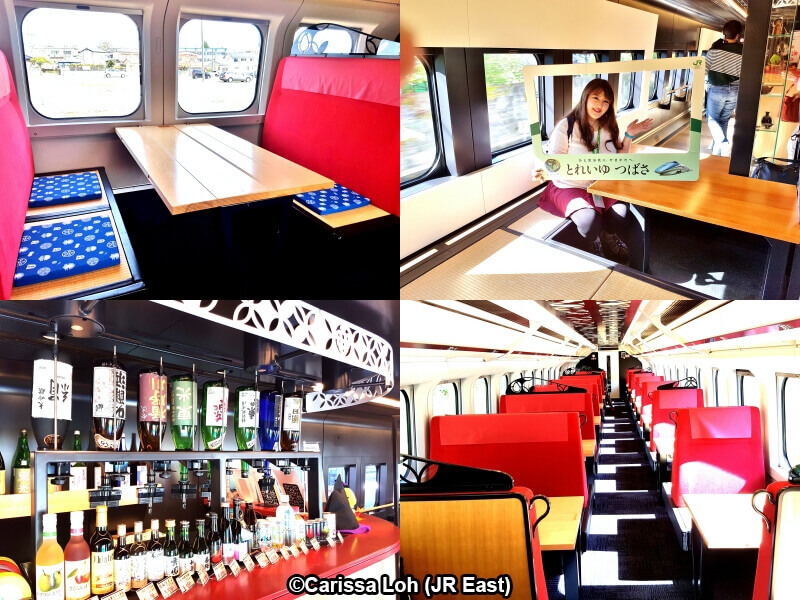
Image credit: Carissa Loh (East Japan Railway Company)
Another eye-catching feature is the bright red tatami passenger seats. These boxed seats have cosy cushions and a large wooden table for you to enjoy your train journey. Car 15 has a tatami seating area for you to try out locally-produced beverages like sake and fruit juices, just like the yuagari-dokoro areas of hot spring resorts.
If you are travelling on the Yamagata Shinkansen Line on a weekend why ride a regular bullet train when you can ride this?
Read this article for an in-depth, personal experience of a trip on the Toreiyu Tsubasa.
For more information, check the train’s website here.
POKÉMON with YOU Train: Pikachus galore
Route: Ichinoseki Station (一ノ関駅) ↔ Kesennuma Station (気仙沼駅) on the Ofunato Line
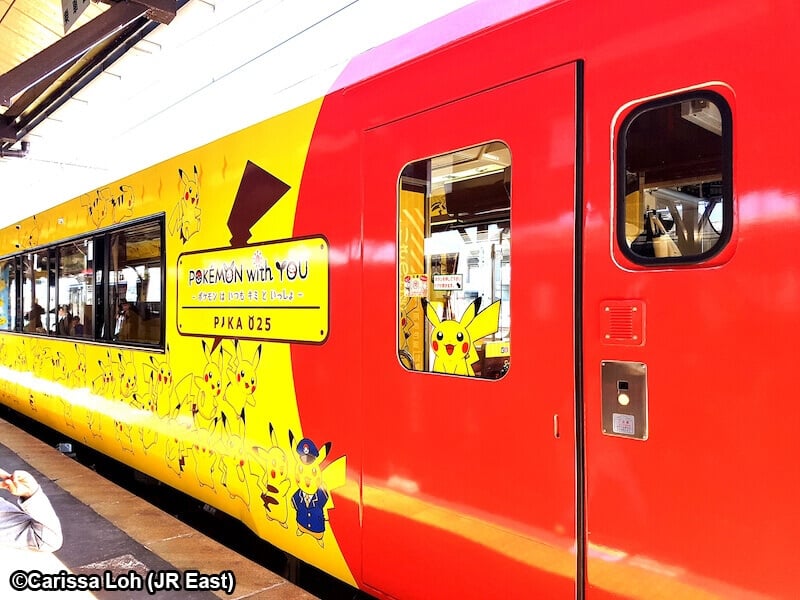
Image credit: Carissa Loh (East Japan Railway Company)
Pika-pika! Fans of the adorable yellow Pikachu wouldn’t want to miss a ride on this POKÉMON with YOU Train. Started in 2012 to bring back smiles to children in the area affected by the 2011 Great Eastern Japan Earthquake and Tsunami, this train got a revamp in 2017 to become its current cheerful Pikachu design.
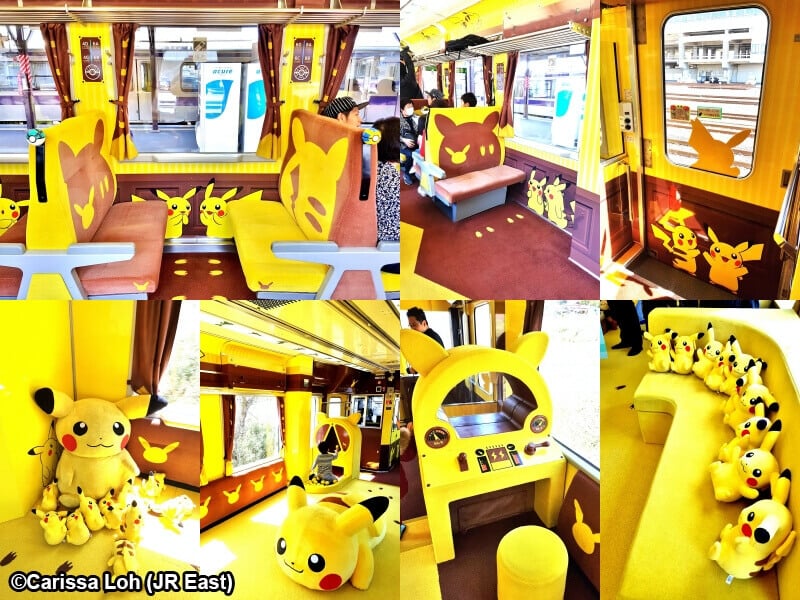
Image credit: Carissa Loh (East Japan Railway Company)
Hundreds of bright and cheery Pikachus adorn the exterior and interior of the train, bringing joy to children and adults alike. Kawaii Pikachu silhouettes and footprints can be found on the seats and floors of the seating car, while dozens of Pikachu plushies await you in the playroom.
Read this article for an in-depth, personal experience of a trip on the POKÉMON with YOU Train.
For more information, check the train’s website here.
Koshino Shu*Kura: a train for sake lovers
Routes:
- Koshino Shu*Kura: Jо̄etsumyо̄kо̄ Station (上越妙高駅) ↔ Tо̄kamachi Station (十日町駅)
- Yuzawa Shu*Kura: Jо̄etsumyо̄kо̄ Station (上越妙高駅) ↔ Echigo-Yuzawa Station (越後湯沢駅)
- Ryuto Shu*Kura: Jо̄etsumyо̄kо̄ Station (上越妙高駅) ↔ Niigata Station (新潟駅)
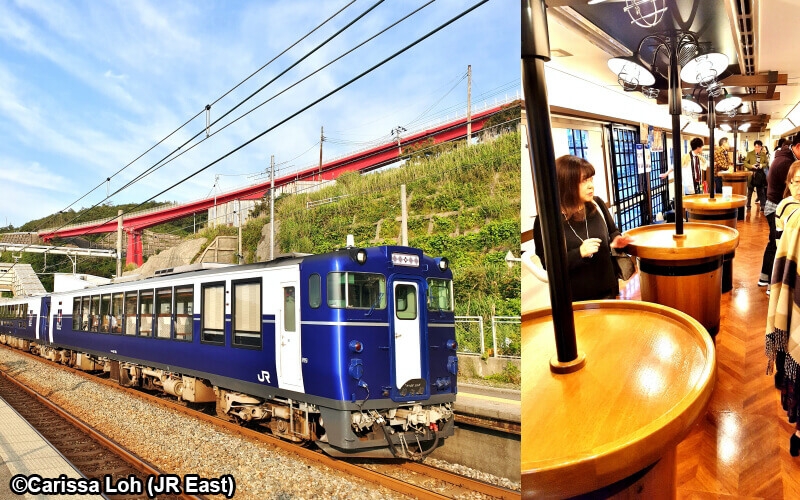
Image credit: Carissa Loh (East Japan Railway Company)
Sake-lovers can’t miss out on the Koshino Shu*Kura, a train beloved by many local sake afficionados. Running in Niigata Prefecture, which is famed for rice and rice products like rice wine (sake), the Koshino Shu*Kura has an interior which is meant to resemble casks at a sake brewery.
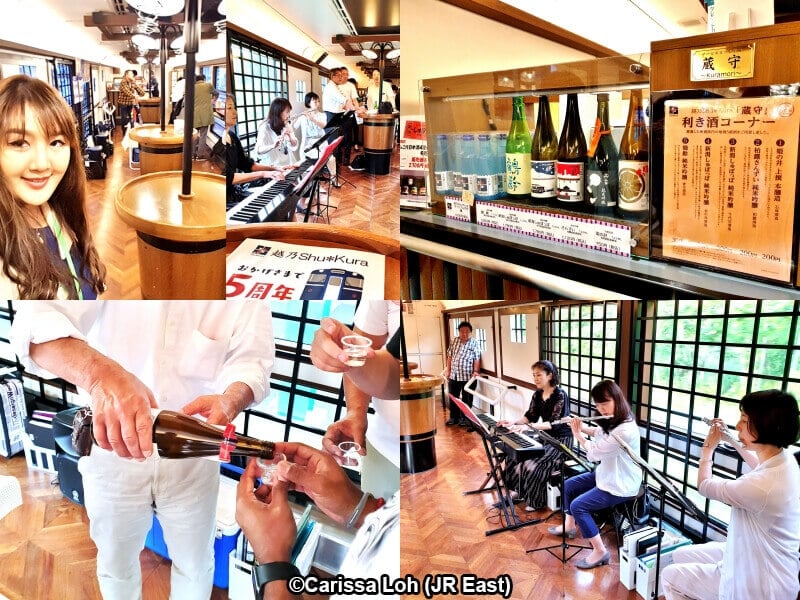
Image credit: Carissa Loh (East Japan Railway Company)
This event space has live jazz performances, free sake -tasting and more. The bar counter is stocked with a variety of locally-produced sake, which change with the seasons.
Niigata Prefecture has the largest number of sake breweries in Japan, and some breweries are even within walking distance of the stations which the Koshino Shu*Kura’s stops at. Combine a ride on this train with a visit to a brewery, or sample a variety of local sake the ponshukan at Nagaoka Station!
Read this article for an in-depth, personal experience of a trip on the Koshino Shu*Kura.
For more information, check the train’s website here.
HIGH RAIL 1375: the train closest to the heavens
Route: Kobuchizawa Station (小淵沢駅) ↔ Komoro Station (小諸駅) on the Koumi Line
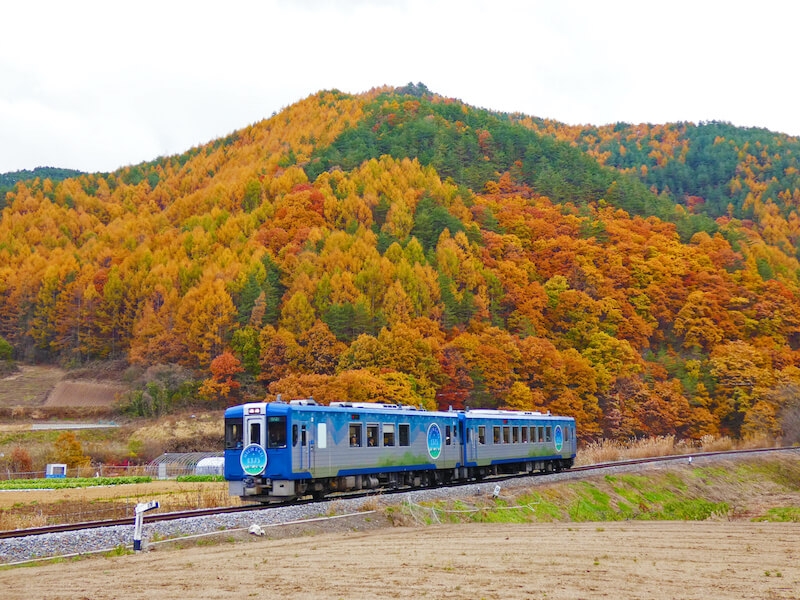
Image credit: East Japan Railway Company
Passing through the highest elevation of railway tracks in Japan (1375m), the HIGH RAIL 1375’s concept is “the train closest to the heavens”. Window-facing seats let you get better views of the splendid Yatsugatake Mountain Range and other highland scenery.
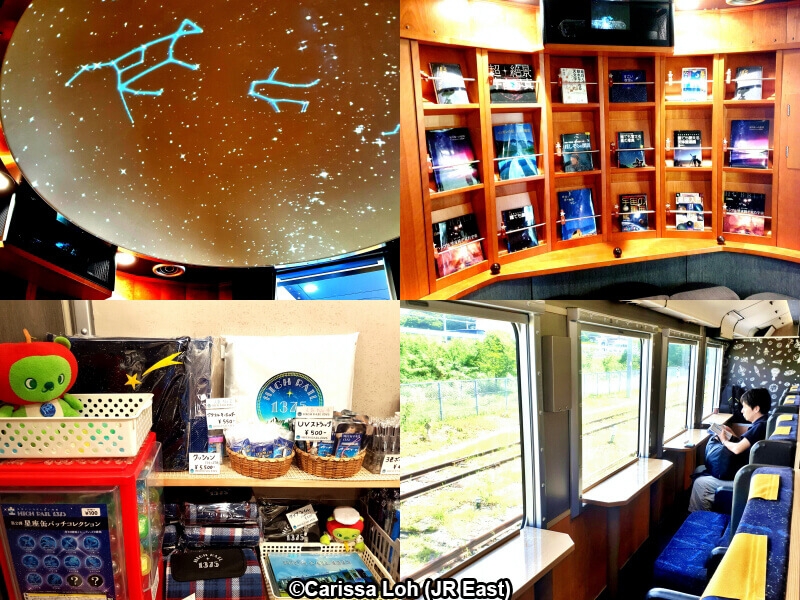
Image credit: Carissa Loh (East Japan Railway Company)
Astronomy fans will be delighted with the on-board domed planetarium (a first for a train) and mini astronomy library. If you take the evening train, the train will stop at Nobeyama Station a free 1-hour stargazing tour. For a fun souvenir, try out the ¥100 gachapon (capsule toy) machine featuring constellations on pin badges.
Read this article for an in-depth, personal experience of a trip on the HIGH RAIL 1375.
For more information, check the train’s website here.
Scenic trains with fun station activities
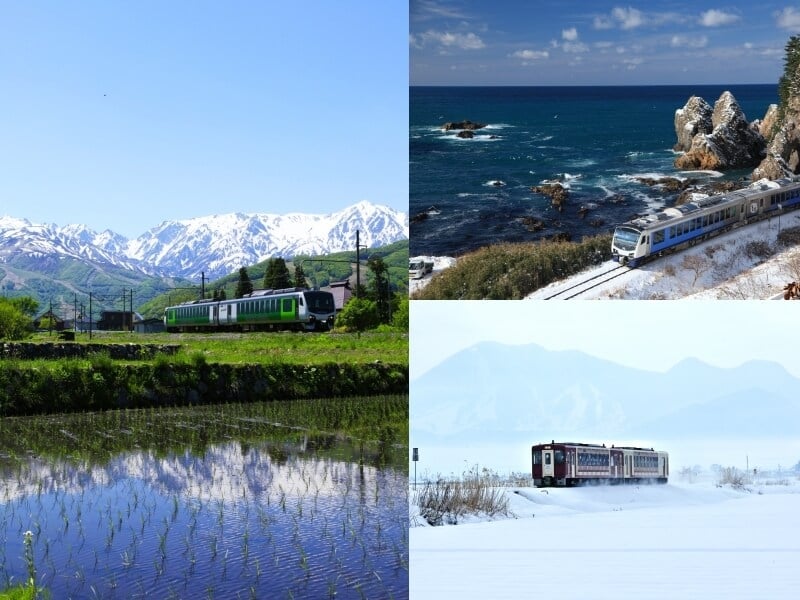
Image credit: East Japan Railway Company
These Joyful Trains traverse routes with beautiful scenery, offering stunning views along the way. At scenic spots along the route, some trains slow down for you to take photos from the large windows, or you can get off at the station to get a closer look, or there are buses to bring you to the places of interest.
Resort Shirakami: the pioneer Joyful Train
Route: Akita Station (秋田駅) ↔ Aomori Station (青森駅) on the Gono Line
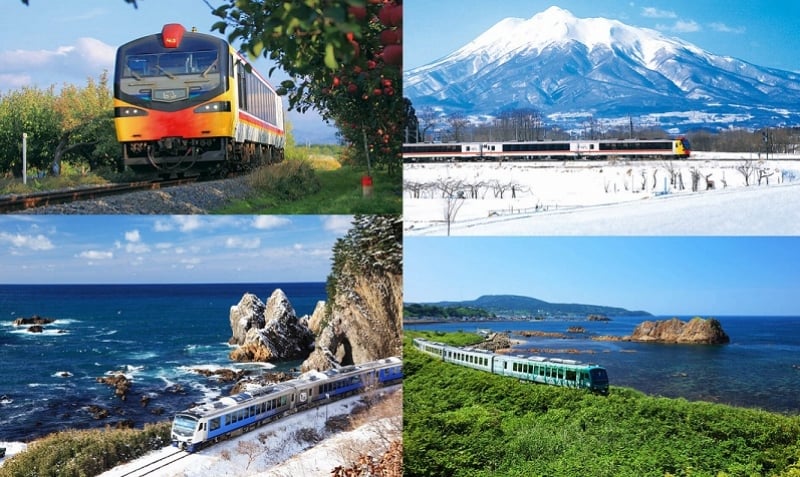
Image credit: East Japan Railway Company
One of the first Joyful Trains to be launched, the Resort Shirakami plies the Gono Line along the coast of the Sea of Japan, offering breathtaking views of both the sapphire sea and the verdant green fields. This train runs almost every day, with up to three trains per direction per day, and is one of the easiest Joyful Trains to ride. There are three difference train vehicles, each named after something from the Shirakami-Sanchi UNESCO World Heritage Site—Buna, Aoike and Kumagera.
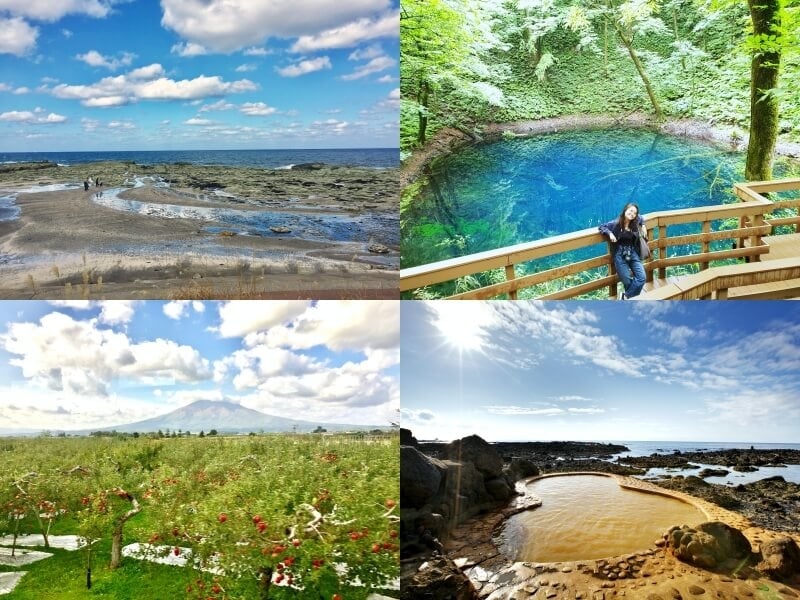
Clockwise from top-left: Senjо̄jiki, Aoike Pond, Koganezaki Furofushi Onsen and apple trees. (Image credit: Akio Kobori, Carissa Loh, Aomori Prefecture, Akio Kobori)
Nearby the stations that the Resort Shirakami passes by are many stunning spots for you to take a short trip to. The train stops at Senjо̄jiki Station for about 15 minutes, where you can get up close to the Sea of Japan. From Jūniko Station, the magical bright blue Aoike Pond is a 15-minute bus ride away. If you like hot springs, the outdoor onsen with a spectacular ocean view at Koganezaki Furofushi Onsen is only a short bus ride from WeSpa Tsubakiyama Station. Near Hirosaki, Japan’s top apple-producing area, you can see hundreds of apple trees from the train.
Read this article for an in-depth, personal experience of a trip on the Resort Shirakami.
For more information, check the train’s website here.
Resort View Furusato: scenic mountain views aplenty
Route: Nagano Station (長野駅) ↔ Minami-Otari Station (南小谷駅) on the Shinonoi and Oito Lines
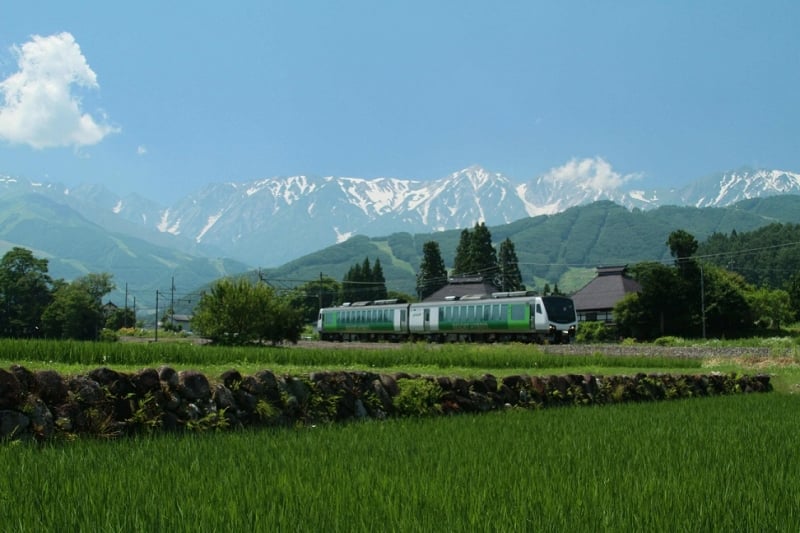
Image credit: East Japan Railway Company
The Resort View Furusato offers panoramic vistas of Japan’s Northern Alps as it runs along the Oito Line parallel to these mountains. From the train’s wide windows, take in the view of the soaring peaks, many of which are close to 3,000m high.
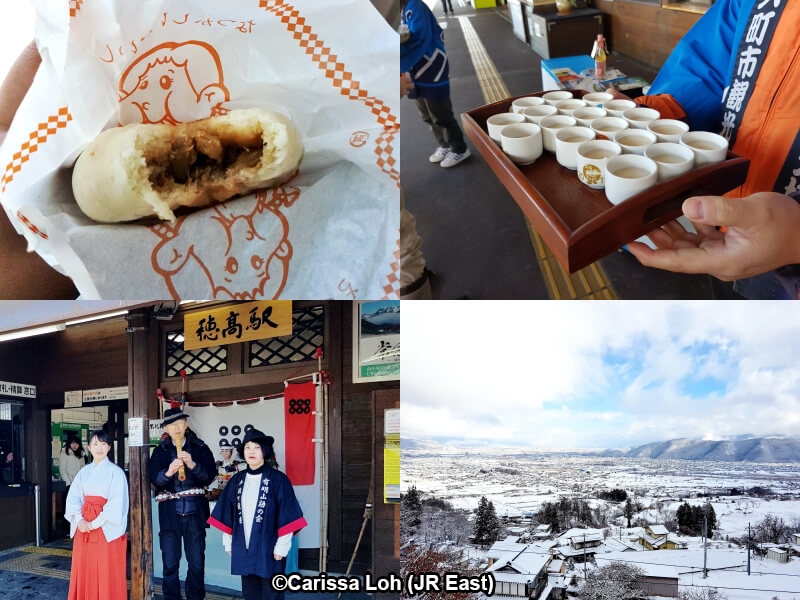
Image credit: Carissa Loh (East Japan Railway Company)
The highlight of this train is the myriad of fun activities at the various station along the ride. Take in a bird’s eye view of the Zenkoji Plains at Obasute Station, explore Hotaka Shrine with a shrine maiden at Hotaka Station, tuck into some local snacks and drinks at Shinano-Omachi Station, and more.
Read this article for an in-depth, personal experience of a trip on the Resort View Furusato.
For more information, check the train’s website here.
Oykot: a cosy countryside ride
Route: Nagano Station (長野駅) ↔ Tо̄kamachi Station (十日町駅) on the Iiyama Line
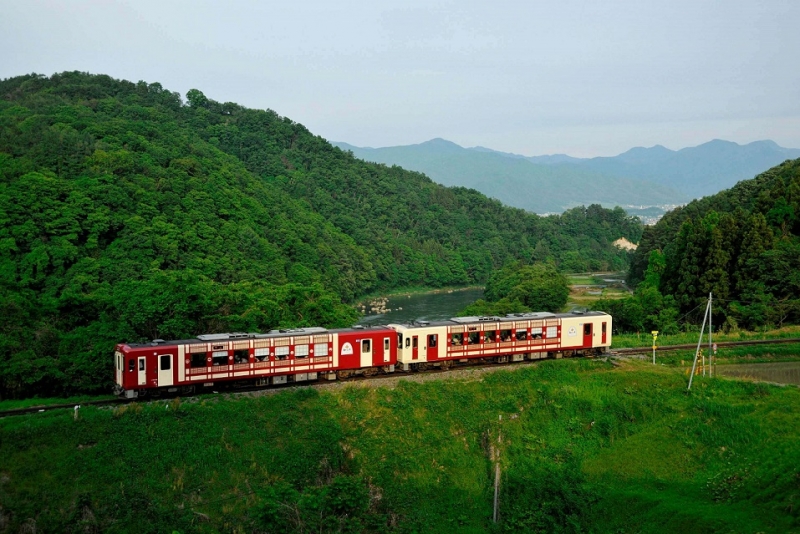
Image credit: East Japan Railway Company
Getting its name from “Tokyo” spelt backwards, the Oykot is meant to be a contrast to the capital city’s fast-paced lifestyle, offering instead a laid-back and nostalgic ride with an interior meant to resemble your grandmother’s cosy countryside home.
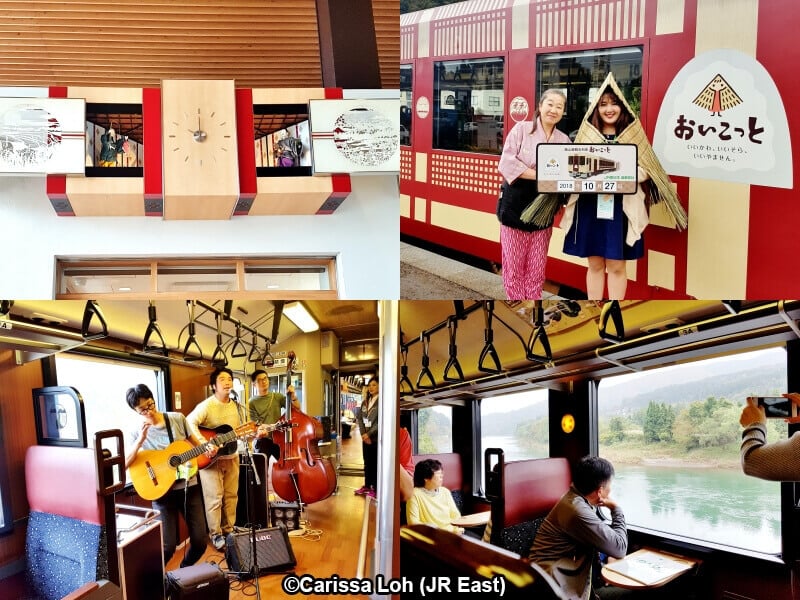
Image credit: Carissa Loh (East Japan Railway Company)
At Iiyama Station, take a look at the karakuri clock, featuring mechanized traditional Japanese dolls moving to the tune of “Furusato”, a famous folk song. At Morimiyanohara Station, take a commemorative photo with sugebо̄shi, a traditional straw umbrella used in the past. This station was where the highest ever snowfall at a train station was recorded. Along the route, the train offers up-close views of the meandering Chikuma River. The town of Nakano is famous for producing folk singers, and if you’re lucky, there might even be a performance by local volunteers on-board!
Read this article for an in-depth, personal experience of a trip on the Oykot.
For more information, check the train’s website here.
Steam locomotive (SL) trains
Treasured relics from the past, these steam locomotives have been restored and repurposed as Joyful Trains.
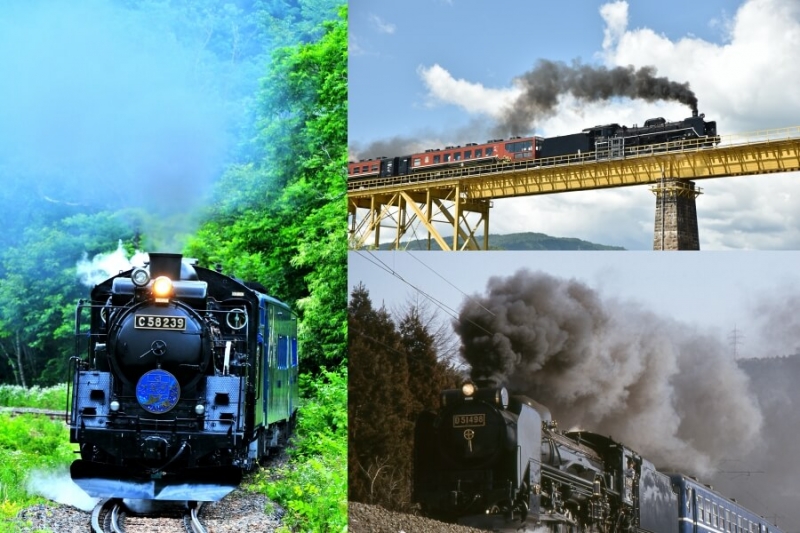
Image credit: East Japan Railway Company
A big hit amongst railway enthusiasts, SL trains offer a glimpse into the past, and let you live out childhood fantasies of riding a choo-choo train. As they are difficult to maintain due to the large quantities of water and coal used, these trains run less frequently than other Joyful Trains, but can carry more passengers per trip. If you are a train fan, don’t miss the chance to ride them if you can!
SL Banetsu Monogatari: enjoy the Ban’etsu West Line
Route: Niitsu Station (新津駅) ↔ Aizu-Wakamatsu Station (会津若松駅) on the Ban’etsu West Line
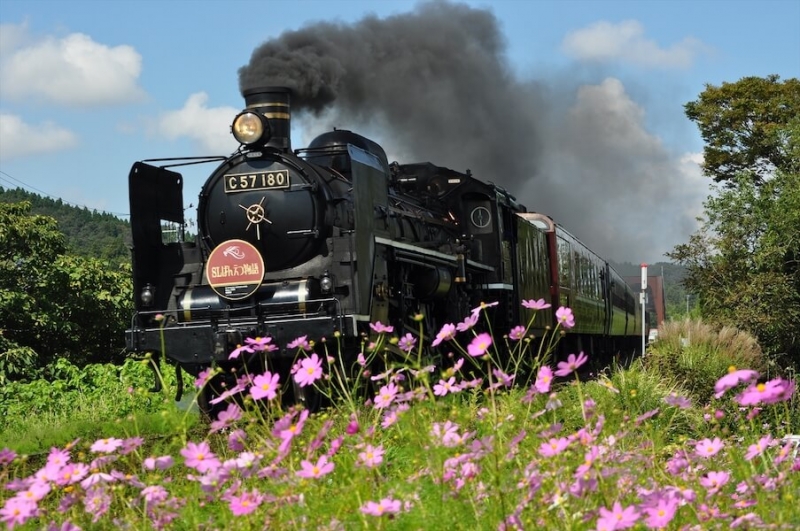
Image credit: East Japan Railway Company
Originally built in 1946, the C57 180 SL train was nicknamed Kifujin (noble lady) due to its graceful appearance. The train was pulled out of retirement in 1999 due to popular demand, and was revived as the SL Banetsu Monogatari. 2019 celebrated the 20th anniversary of this beloved train, and hopefully it will continue to chug along for many more years!
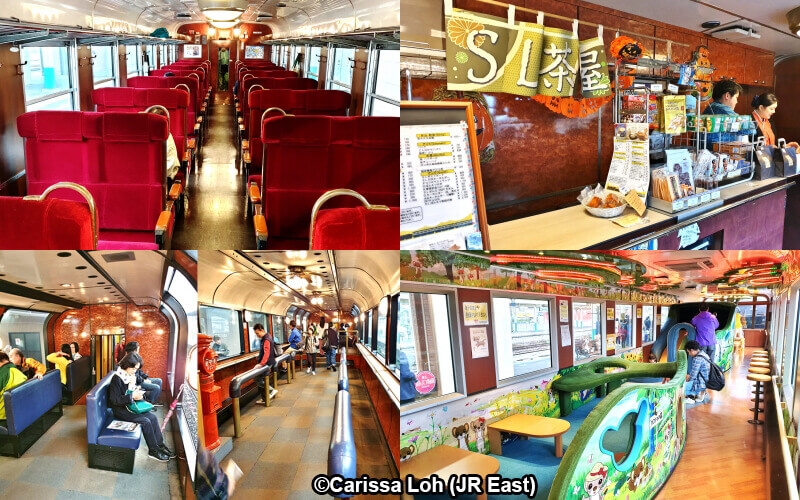
Image credit: Carissa Loh (East Japan Railway Company)
The train’s crimson velvet seat covers and wooden finishes on the armrests, walls and hooks create a nostalgic atmosphere reminiscent of Japan’s beloved Taishō Era (1912–1926). On-board there are also observation spaces, a sales counter, and a play area for children, all of which can be freely used by all passengers.
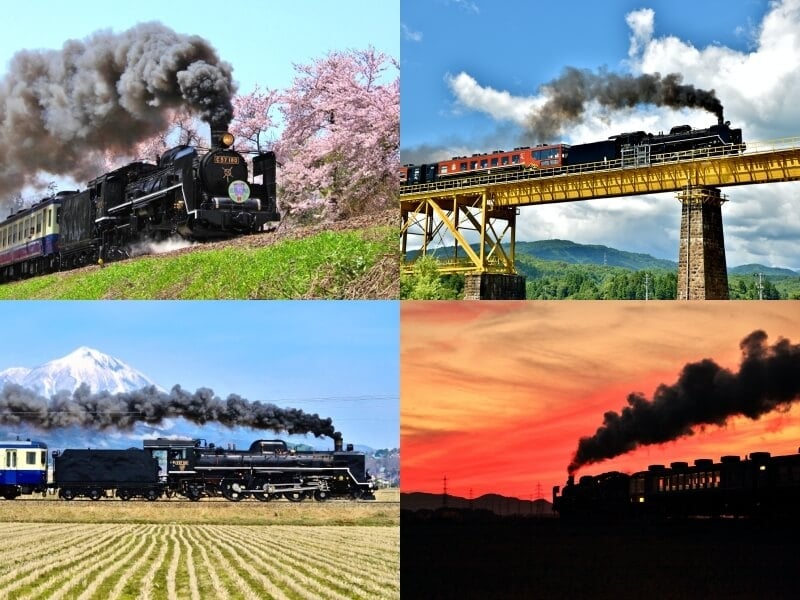
Image credit: East Japan Railway Company
The SL Banetsu Monogatari runs on the scenic Ban’etsu West Line, which is known for its beautiful greenery, flowing rivers and photo-taking spots. Many fans prefer to take photos of SL trains, and the Ban’etsu West Line offers some of the best train photography locations.
Read this article for an in-depth, personal experience of a trip on the SL Banetsu Monogatari.
For more information, check the train’s website here.
SL Ginga: the railway to the stars
Route: Hanamaki Station (花巻駅) ↔ Kamaishi Station (釜石駅) on the Kamaishi Line
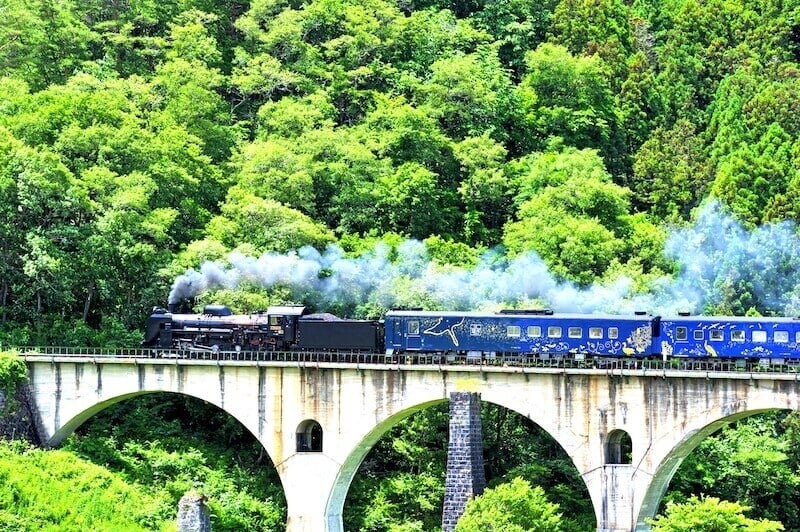
Image credit: East Japan Railway Company
The magical SL Ginga (SL銀河) brings to life Miyazawa Kenji’s beloved classic “Night on the Galactic Railroad” (Ginga Tetsudo no Yoru). The train was restored from the C58 239 SL train, in order to revitalise the disaster-stricken Iwate region after the 2011 Great Eastern Japan Earthquake and Tsunami.
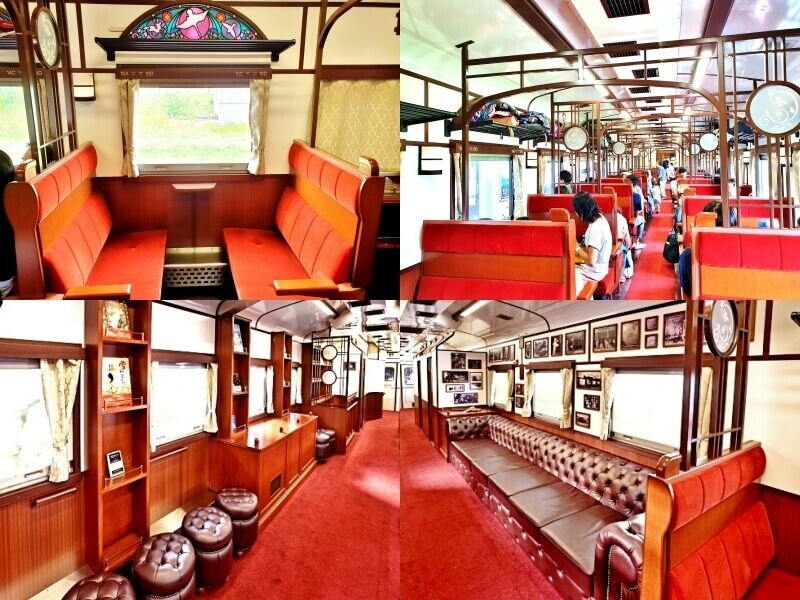
Image credit: Carissa Loh / East Japan Railway Company
Once you board the train, the stained-glass windows, mock gaslights and vintage booth seats will make you feel as if you have stepped back into the early 20th century. Have fun on your trip while checking out the various galleries dedicated to Miyazawa Kenji, as well as the on-board optical planetarium, the first ever for a train.
Read this article for an in-depth, personal experience of a trip on the SL Ginga.
For more information, check the train’s website here.
SL Gunma: feel the power of an SL train
Routes:
- SL Gunma Minakami: Takasaki Station (高崎駅) ↔ Minakami Station (水上駅) on the Joetsu Line
- SL Gunma Yokokawa: Takasaki Station (高崎駅) ↔ Yokokawa Station (横川駅) on the Shin-etsu Main Line
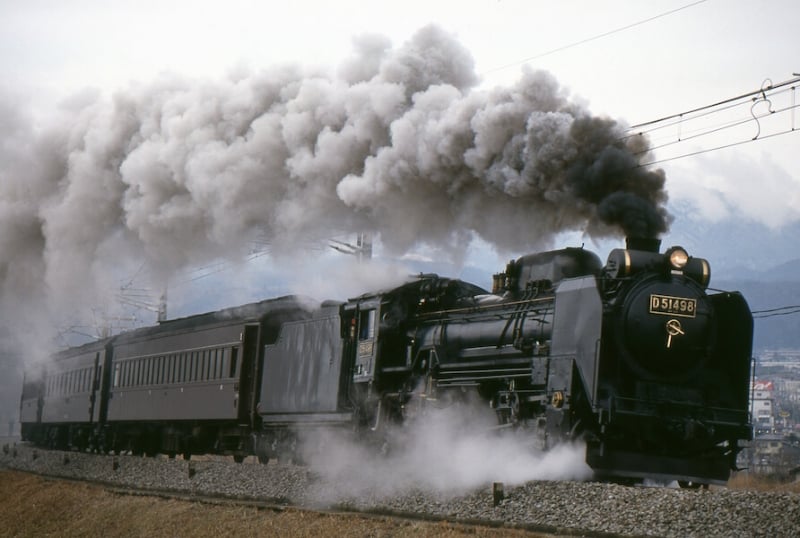
Image credit: East Japan Railway Company
Hardcore SL train fans would know that the most powerful SL trains are the D-series trains, which were used in the past for hauling freight cars. Very rarely would you get a chance to experience riding these, but guess what? One of them, the D51 498, has been repurposed for the SL Gunma! Together with the C61 20, these two SL trains take turns to make the SL Gunma’s trips between Takasaki Station and either Minakami Station (SL Gunma Minakami) or Yokokawa Station (SL Gunma Yokokawa).
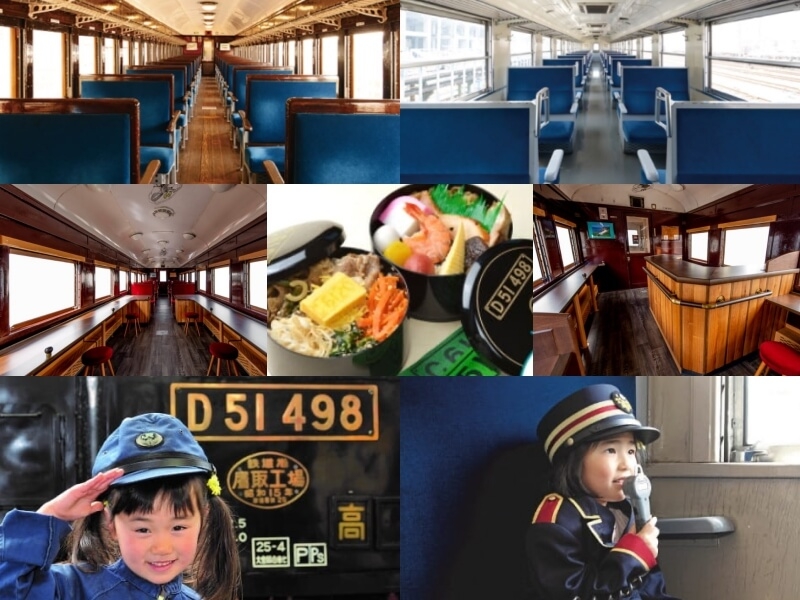
Image credit: East Japan Railway Company
If you’re setting off from Takasaki Station, try out a special SL Gunma ekiben (lunch box for eating on the train). For the inbound journey, little ones can take commemorative photos in a train driver’s outfit, or experience being a train conductor, even making live announcements on the train!
For more information, check the train’s website here.
Restaurant trains (with scenic views)
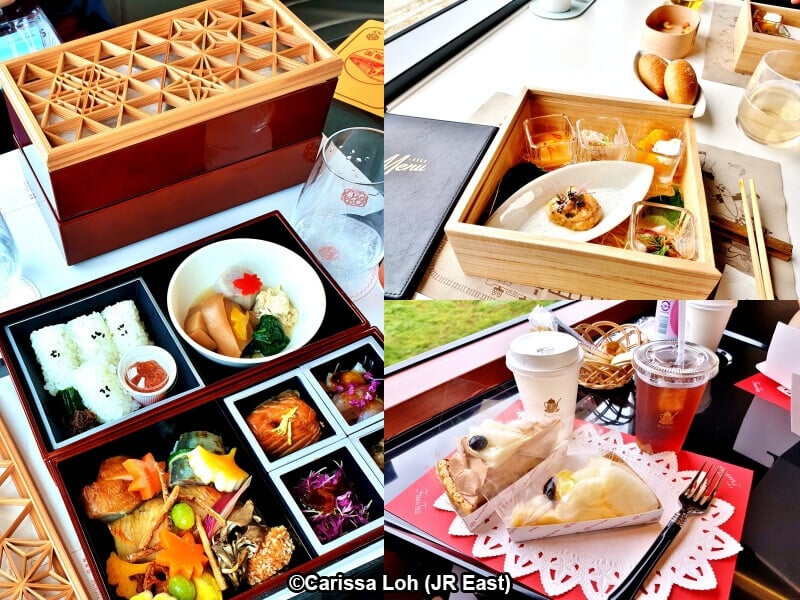
Image credit: Carissa Loh (East Japan Railway Company)
For foodies seeking a novel train experience, how about taking a trip on one of the three restaurant trains? Joyful Trains in this category offer mouth-watering meals made with locally-produced ingredients, so you can enjoy a good meal while supporting the local farmers at the same time. In addition, these trains also pass by scenic routes, and offer mesmerizing views right from the comfort of your seats.
TOHOKU EMOTION: the fine-dining restaurant train
Route: Hachinohe Station (八戸駅) ↔ Kuji Station (久慈駅) on the Hachinohe Line
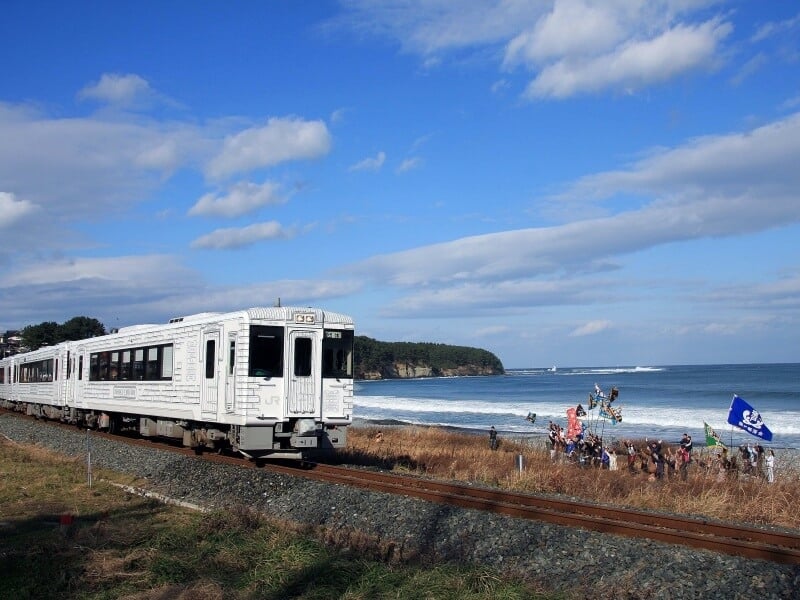
Image credit: East Japan Railway Company
The flagship of JR East’s dining trains, the TOHOKU EMOTION is a fine-dining restaurant train that incorporates the elements of local and luxury into its dining experience. This train was started in 2013 to support tourism to the Sanriku Coast, which was badly affected by the 2011 Great Eastern Japan Earthquake and Tsunami. Along the journey, it is not uncommon to see locals energetically waving to the train as it passes by.
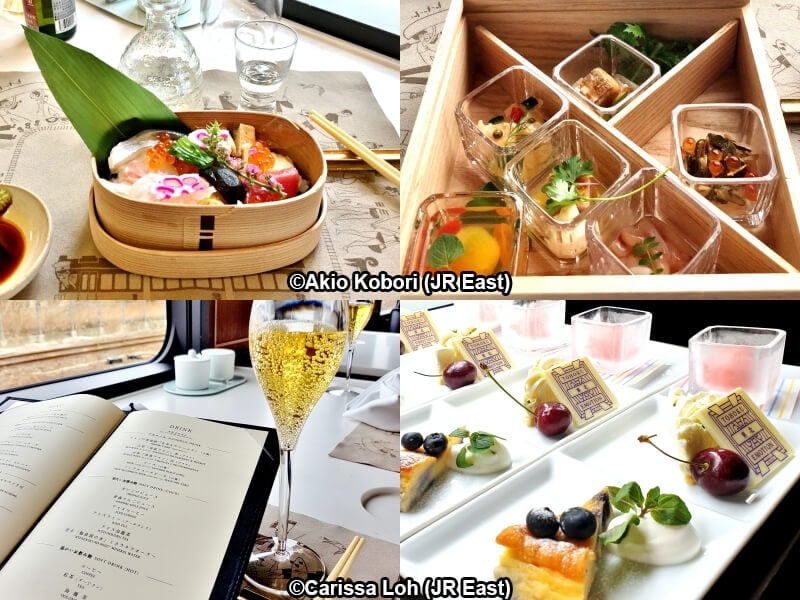
Image credit: Carissa Loh and Akio Kobori (East Japan Railway Company)
A journey on this “Tohoku Restaurant Railway” will tantalise your taste buds with locally-produced Tohoku ingredients in all of its carefully thought-out dishes, and delight you with five-star service from the dedicated staff.
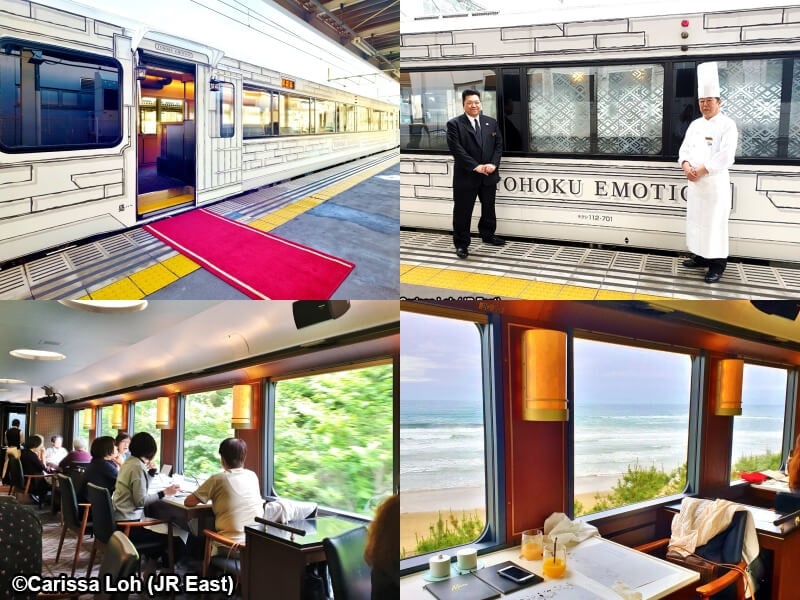
Image credit: Carissa Loh (East Japan Railway Company)
Running along the Sanriku Coast, enjoy unobstructed views of the Pacific Ocean’s cerulean waters from right inside the train. From spring to autumn, you can also get a view of the lush greenery that the train passes by. There is a live kitchen on-board, where you can witness the chefs preparing your meals.
Read this article for an in-depth, personal experience of a trip on the TOHOKU EMOTION.
For more information, check the train’s website here.
FruiTea Fukushima: the travelling café train
Route:
- Kо̄riyama Station (郡山駅) ↔ Kitakata Station (喜多方駅) on the Ban’etsu West Line (regular)
- Kо̄riyama Station (郡山駅) ↔ Sendai Station (仙台駅) on the Tohoku Main Line (winter)
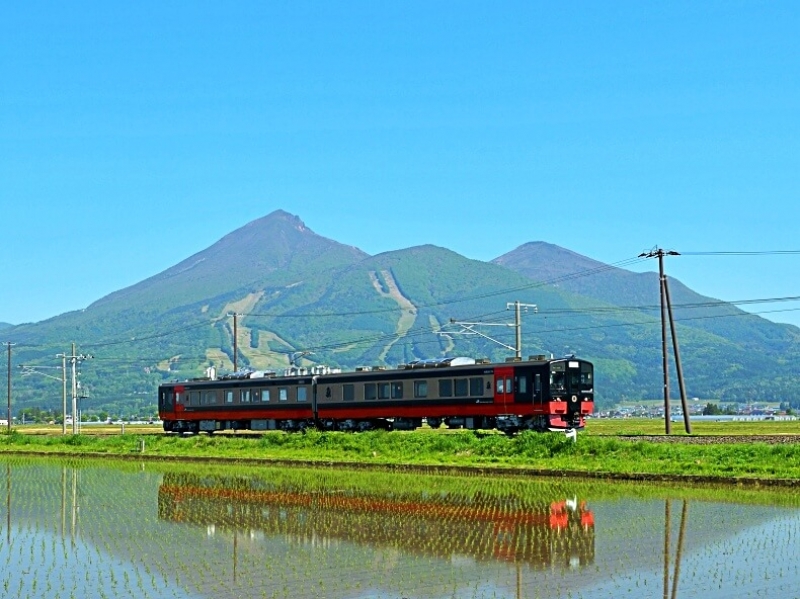
Image credit: East Japan Railway Company
Do you have a sweet-tooth, or do you enjoy desserts at cafés? If you answered “yes”, then the FruiTea Fukushima is the train for you! This train will charm your sweet-tooth with its seasonal tarts and pastries—made freshly with only the current fruits in season.
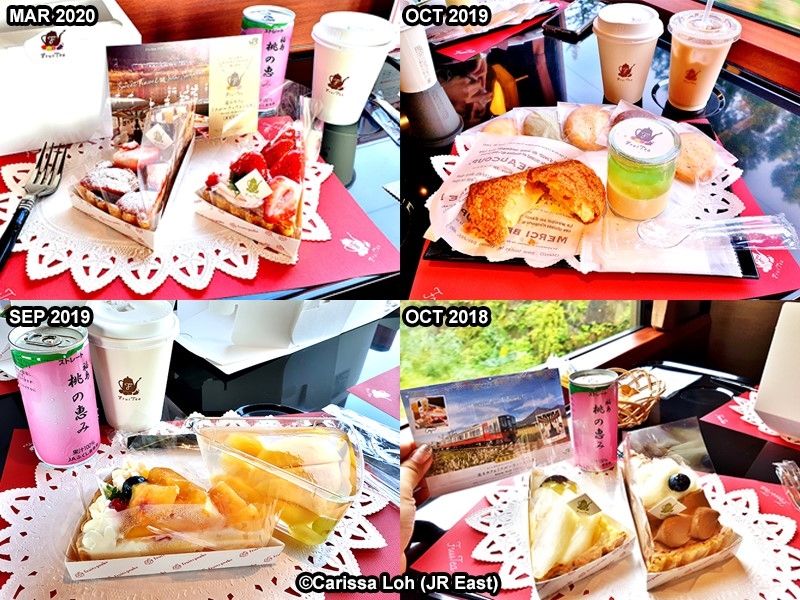
Image credit: Carissa Loh (East Japan Railway Company)
The menu changes every month, so even in the same season, you can experience different flavours. Solo travellers will be glad to know that the FruiTea Fukushima is the only restaurant train in the line-up that accepts single-traveller reservations.
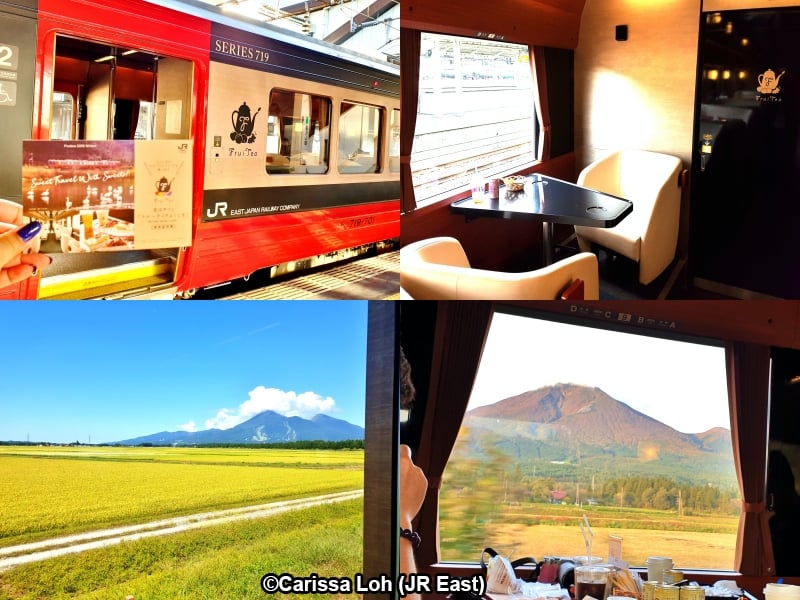
Image credit: Carissa Loh (East Japan Railway Company)
Shades of red and black cover this train, and the interior resembles a trendy café with its white leather armchair sofa seats. Running on the mountainous Ban’etsu West Line, from the windows you can see amazing scenery of Mount Bandai and the rice fields around Inawashiro.
Read this article for an in-depth, personal experience of a trip on the FruiTea Fukushima.
For more information, check the train’s website here.
KAIRI: gastronomic delights from Niigata and Shonai
Route: Niigata Station (新潟駅) ↔ Sakata Station (酒田駅) on the Uetsu Main Line
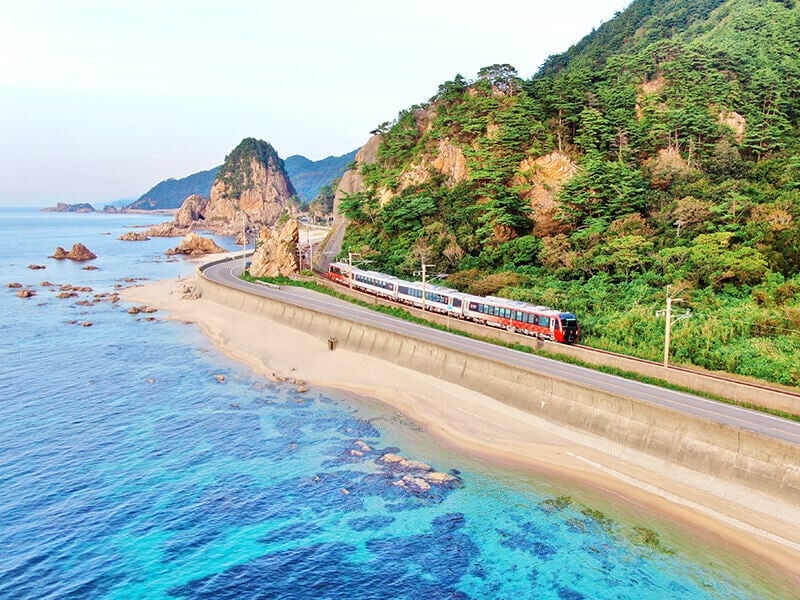
Image credit: East Japan Railway Company
Saving one of the best for last, the KAIRI is the newest Joyful Train in the line-up, and got its name from the beautiful sea (kai) and charming countryside villages (ri) that are plentiful in the area. This train focuses on the local gastronomy of the Niigata and Shonai Regions, as well as the breathtaking views of the Sea of Japan that it passes by on the Uetsu Main Line.
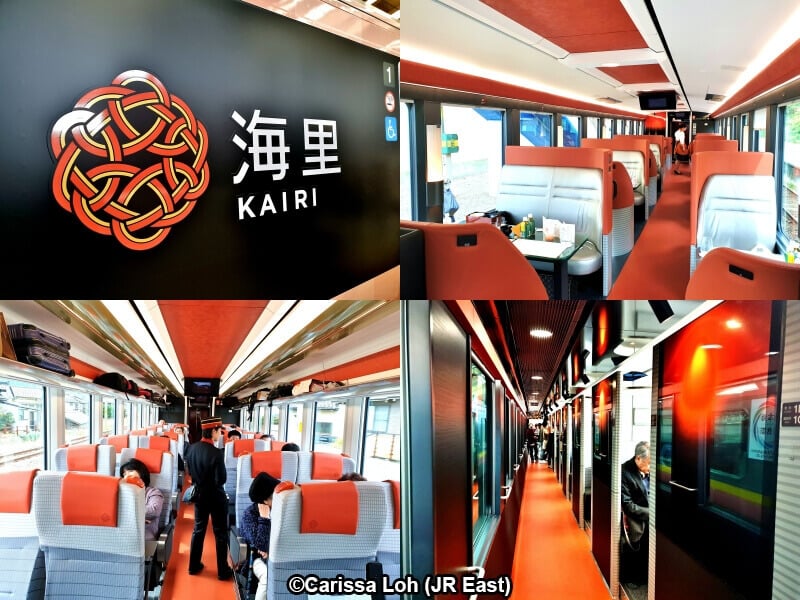
Image credit: Carissa Loh (East Japan Railway Company)
Unlike the TOHOKU EMOTION and the FruiTea Fukushima, which are travel package-only restaurant trains, the KAIRI has one dedicated travel package-only dining car (Car 4), while the other cars can be boarded with without packages.
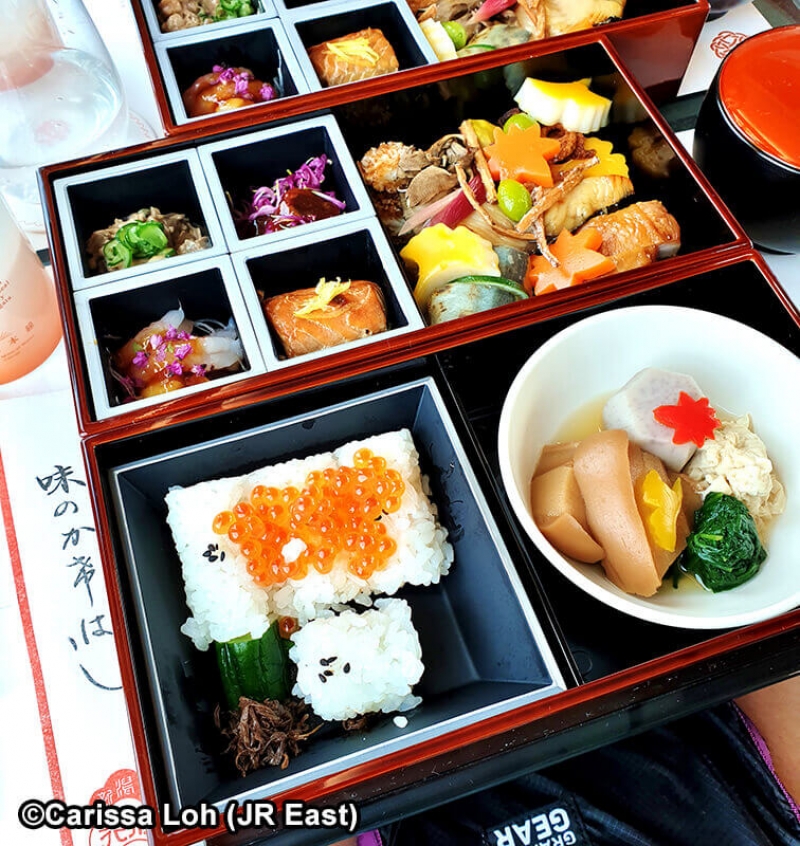
Image credit: Carissa Loh (East Japan Railway Company)
Undoubtedly, most people ride the KAIRI for the gastronomic experience, as the exquisite dishes are sure to tempt your taste buds. Even if you are not riding in Car 4, pre-order bento (lunch boxes) are available for all passengers who want a taste of what the KAIRI has to offer!
Read this article for an in-depth, personal experience of a trip on the KAIRI.
For more information, check the train’s website here.
How to ride Joyful Trains
If you are thinking of visiting Eastern Japan or riding some of these Joyful Trains, check out the JR EAST PASS. JR East Passes offer substantial discounts on train fares, and unlike other passes, are flexible—choose any 5 days within a 14-day period.
There are two types of passes, with both offering unlimited rides on JR East lines (including bullet trains and Joyful Trains) in their designated areas for any 5 days of your choice.
JR EAST PASS (Tohoku area)
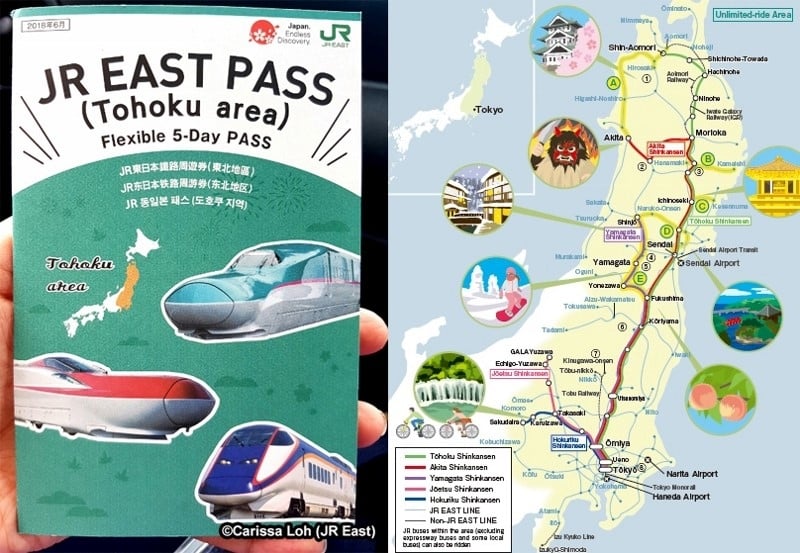
Image credit: East Japan Railway Company
If your trip is mostly in the Tohoku Region, check out the JR EAST PASS (Tohoku area), At only ¥19,350 when purchased overseas, it costs less than a round-trip between Tokyo and Sendai (~¥23,000), and the 5 days do not have to be consecutive.
Joyful Trains that can be ridden for free with the JR EAST PASS (Tohoku area):
- HIGH RAIL 1375
- KAIRI(only between Murakami and Sakata)
- POKÉMON with YOU Train
- Resort Shirakami
- SL Banetsu Monogatari(only between Aizu-Wakamatsu and Nozawa)
- SL Ginga
- SL Gunma
- Toreiyu Tsubasa
JR EAST PASS (Nagano, Niigata area)
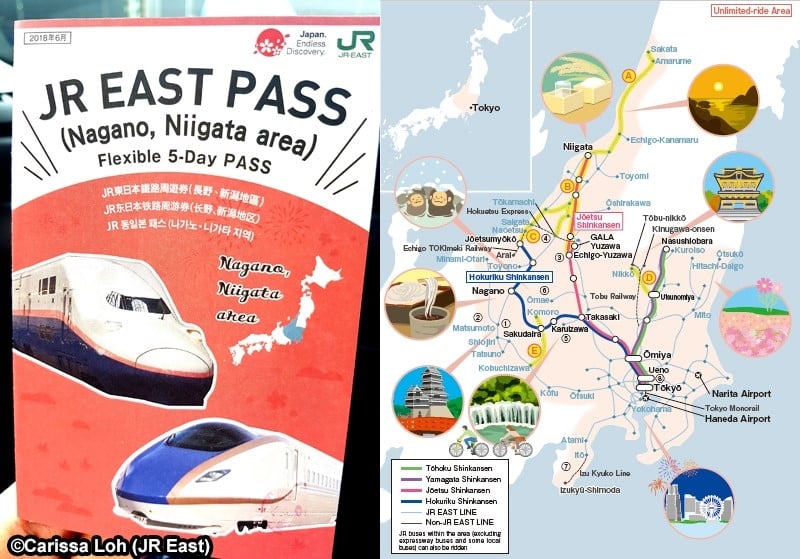
Image credit: East Japan Railway Company
If your trip is mostly in Niigata and Nagano, check out the JR EAST PASS (Nagano, Niigata area), At only ¥17,310 when purchased overseas, it costs less than a round-trip between Tokyo and Niigata (~¥21,000), and the 5 days do not have to be consecutive.
Joyful Trains that can be ridden for free with the JR EAST PASS (Nagano, Niigata area):
- HIGH RAIL 1375
- KAIRI
- Koshino Shu*Kura
- Oykot
- Resort View Furusato
- SL Banetsu Monogatari(only between Niitsu and Hideya)
- SL Gunma
Online seat reservations
All the Joyful Trains mentioned in this article require seat reservations in order to board. JR EAST PASS holders can make seat reservations for the covered trains for free, either online (here) up to 1 month in advance, or in-person after arriving in Japan.
Restaurant train meal packages
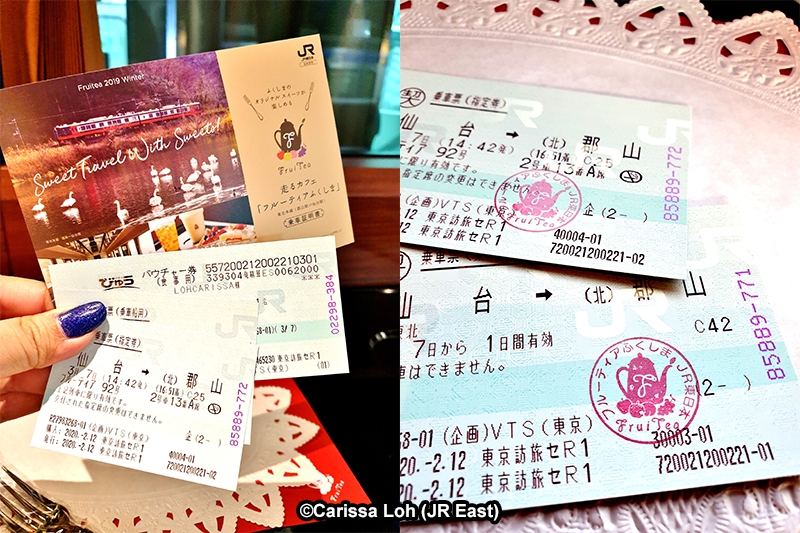
Image credit: Carissa Loh (East Japan Railway Company)
For the TOHOKU EMOTION, FruiTea Fukushima, and Car 4 of the KAIRI, only passengers who have purchased meal packages may board. Even if you have a rail pass, you will not be able to board these trains.
Reservations for meal packages can be made at JR East Travel Service Centers at major train stations like Tokyo Station, Ueno Station, Shinjuku Station and more. The ones at the major stations even have English-speaking staff to better assist you with your travel needs. Reservations are on a first-come-first-served basis.
This article was brought to you by JR East (East Japan Railway Company), and was originally published on JR Times.
|
Great news! The JR EAST PASS (Tohoku area) and JR EAST PASS (Nagano, Niigata area) offer UNLIMITED RIDES on all JR East Rail Lines in the designated area, and is also valid for the Narita Express to/from Narita Airport, Tokyo Monorail to/from Haneda Airport and all Shinkansen lines. Did we mention you also get free rides on the uniquely-themed Joyful Trains, like the ones mentioned in this article, with a JR EAST PASS? The pass is valid for use for any five days within a 14-day period after collection, giving you flexibility and ample time to explore each area without rushing to the next. Secure advance seat reservations for free up to one month before departure so you won’t have to deal with peak tourist seasons once the holiday rush sets in. A friendly reminder — you can purchase your JR EAST PASS in Japan, or through licensed sales agents overseas. But before you go, here’s a budget hack: The pass is about ¥1,000 cheaper if you purchase it from travel agents. Contact the travel agencies below to get your very own JR EAST PASS today! |

JTB
Tel: 6595 0600
Website (Singapore)
Website (Malaysia)

H.I.S.
Tel: 6222 1230
Website (Singapore)
Website (Malaysia)
